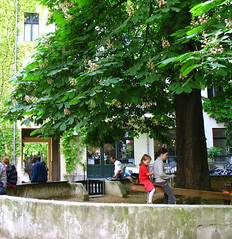Connecting neurons and neighborhoods: kids' health and urban planning

Posted April 12, 2011 at 1:26PM
Today's entry is a guest post from my NRDC colleague, Marissa Ramirez:
I came to the environment through public health, having been a biologist and cancer researcher before studying urban planning and coming to NRDC. And, like many in the field, I thought of human health as the product of two separate components: our genetic makeup and our environment. But now I am starting to see that the two components aren’t as distinct as I once thought and, as a result, healthy neighborhoods may be even more important than we have realized.
In particular, we know that health profiles of disadvantaged and impoverished neighborhoods are significantly worse than those in thriving communities. It is now well understood that environmental factors such as poor air quality and food deserts, for example, contribute to a familiar list of ailments, including asthma and obesity. But developing research indicates that our environment can also affect our gene expression.
In an article on poverty and illness published last month in The New Yorker, Paul Tough reported that neurobiologists have found that adversity in early childhood, such as living in unsafe conditions, economic hardship, violence or neglect from families,  causes acute and chronic stress responses at the molecular level. This modifies the chemistry of DNA in the brain in such a way as to have an adverse effect on adulthood.
causes acute and chronic stress responses at the molecular level. This modifies the chemistry of DNA in the brain in such a way as to have an adverse effect on adulthood.
The leading study is Neurons to Neighborhoods: the Science of Early Childhood Development, published in 2000 by the National Research Council and Institute of Medicine. Individuals were rated on the level of distress experienced during youth, and the researchers found that stressful childhoods caused the activation of genes that direct the expression of stress hormones, resulting in higher rates of aggressive behavior, depression, or weakened immunity in adulthood. Even after adjusting for risky behaviors like drug use, those that had the highest stress ratings during their youth had the poorest health outcomes later in life.
The results reveal a need for more thoughtful policies in preventative medicine and childhood development. But I would argue that the knowledge that the way we live as children will affect our genes as adults also strengthens the rationale for designing sustainable communities. The environment in which we grow will certainly never be perfect but, by designing healthy, sustainable places to live, we can help to keep stress hormones balanced and create a better environment for protein synthesis.
For example, envision young children frolicking among patches of green space, sampling fresh produce from the local market, and nurturing healthy relationships with other kids and teachers at school. Imagine that stay-at-home sick days are few and families have access to affordable health care, doctors’ visits, and emotional support as needed. These are factors that can be influenced, if not controlled, by attention to neighborhood circumstances.
 Those regularly following Kaid’s blog may recall NRDC’s partnership with the Local Initiatives Support Corporation (LISC) to “create model smart, green, inclusive redevelopment.” The project aims to implement LEED for Neighborhood Development, reflecting a high standard of environmental practice, in underserved communities. The project also includes a research component to rigorously quantify the benefits of inclusive, thoughtful revitalization in distressed neighborhoods. We hope that the way in which our redevelopment practices affect health outcomes can be a significant component of this assessment. Our goal is to generate data that can strengthen revitalization efforts in order to support significant long term health benefits.
Those regularly following Kaid’s blog may recall NRDC’s partnership with the Local Initiatives Support Corporation (LISC) to “create model smart, green, inclusive redevelopment.” The project aims to implement LEED for Neighborhood Development, reflecting a high standard of environmental practice, in underserved communities. The project also includes a research component to rigorously quantify the benefits of inclusive, thoughtful revitalization in distressed neighborhoods. We hope that the way in which our redevelopment practices affect health outcomes can be a significant component of this assessment. Our goal is to generate data that can strengthen revitalization efforts in order to support significant long term health benefits.
The interaction between heredity and environment in many ways has guided what it means to be a human since early civilization. But it is time to transform this question of nature versus nurture in a way that emphasizes the inseparability of the two. We must do this by advocating for planning as a powerful tool for preventative medicine. While planners may not be performing genetic analysis in the near future, we should account for environmental damages from health issues at the molecular level. Finally, we need additional collaboration among the disciplines of medicine, environment and urban planning to inform the best community development and design.
You may wonder what a former lab-coat wearing molecular biologist is doing advocating for sustainable communities at a leading environmental organization. It turns out she is fostering healthy neuromuscular junctions and optimal epigenetics -- one sustainable neighborhood at a time.
Marissa Ramirez is part of NRDC's sustainable communities team.
Move your cursor over the images for credit information.
